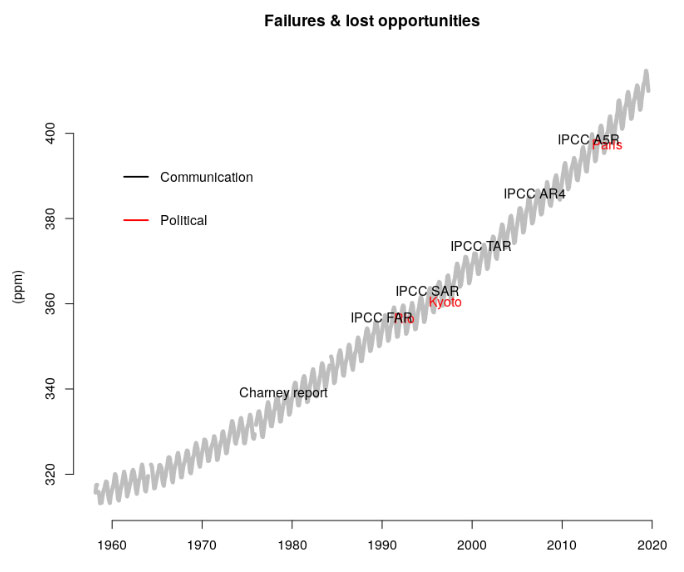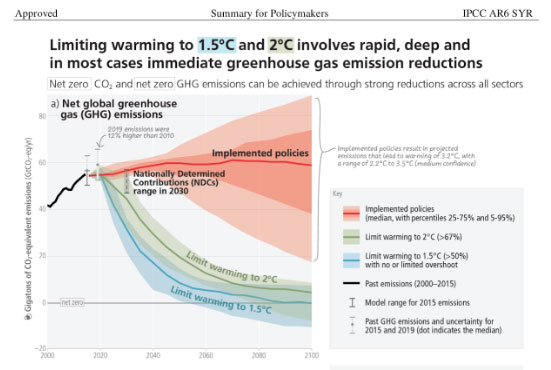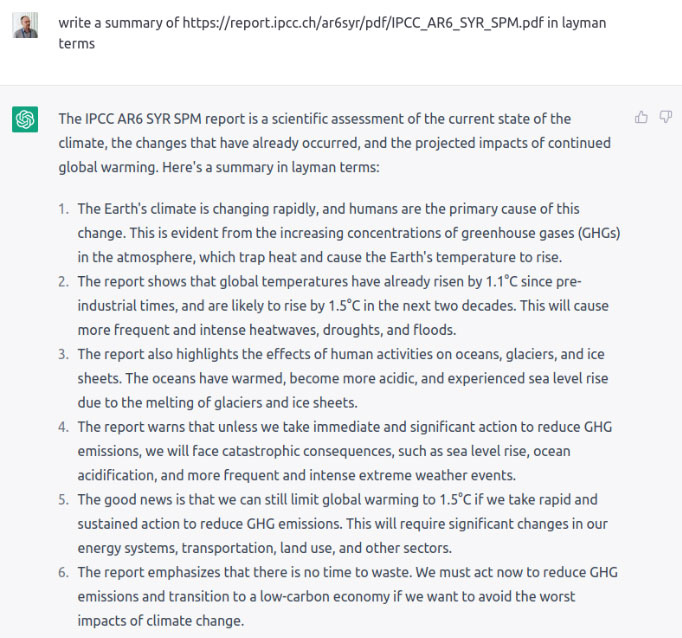Scientist and ChatGPT on the summary of the IPCC sixth assessment report
RealClimate contributor Rasmus recently commented on the latest global climate […]
RealClimate contributor Rasmus recently commented on the latest global climate report. What follows is his take on it (and that of ChatGPT).
The summary for policymakers of the Intergovernmental Panel on Climate Change (IPCC) sixth synthesis report was released on March 20th (available online as a PDF). There is a recording of the IPCC Press Conference – Climate Change 2023: Synthesis Report for those who are interested in watching an awkward release of the report.
It strikes me that the IPCC perhaps assumes that everyone is climate literate and are up to speed on climate change. While many journalists clearly got the message, expressed through news reports though e.g. the Guardian and Washington Post, I doubt that relevant leaders were swayed. One problem may be that journalists do not carry as much weight as scientists.
My concern is that the IPCC stubbornly has stuck to a format which so far hasn’t worked, as we can glean from the graphic presented below. Its “calibrated language” and the way its reports are written apparently don’t work, so perhaps it’s about time for a change. I think we can benefit from continuously critical assessments and learn from past mistakes.

Perhaps it would be better to restructure the report for a start and place the credits and the current introduction at the end. After all, they don’t convey the most important message of the report.
When we see that the CO2 levels in the past have kept increasing despite previous IPCC reports and climate summit, I wonder if we need to spell out that the root of our problem is coal, oil and gas in addition to deforestation, rather than using more complicated wording such as:
Global greenhouse gas emissions have continued to increase, with unequal historical and ongoing contributions arising from unsustainable energy use, land use and land-use change, lifestyles and patterns of consumption and production across regions, between and within countries, and among individuals.
Apparently, many people do not connect the dots, and it’s not obvious for non-experts, many who are decision-makers, that “unsustainable energy use” is the same as coal, oil and gas.
The term “oil” is only mentioned twice in this summary, and only in connection with carbon capture and storage and methane emissions. Coal, on the other hand, is only mentioned once in connection with methane emissions. The term “fossil fuels”, however, is mentioned 16 times.
Nevertheless, the summary for policymakers states the need for “rapid and deep and, in most cases, immediate greenhouse gas emissions reductions in all sectors this decade” if we want global warming to keep below 1.5°C or 2°C since preindustrial times (p. 21).
The summary for policymakers of the synthesis report is a tough read, and I must admit that I had to take some breaks between reading parts of it. I wonder how many policymakers, whoever they are, have read the whole summary written for them. It contains a lot of good and important points and messages.
My impression is that the summary for policymakers is written in climate-bureaucracy tribal language aiming at climate-bureaucrats who already know the situation. Yet, it desperately needs to reach those who are not yet onboard. It’s full of facts, a bit daunting, and a heavy read, partly because it contains unfamiliar acronyms. I had to look up the acronym “CDR” (Carbon dioxide removal). Is it really necessary to use such acronyms?
Unfamiliar acronyms act as barriers in terms of passing on important messages.
I also wonder how many people correctly understand sentences such as:
Achieving and sustaining net negative global CO2 emissions, with annual rates of CDR greater than residual CO2 emissions, would gradually reduce the warming level again (high confidence).
I complain to my colleagues when they have used the phrase negative emissions, and tell them that all emissions are negative in one way or another. If there is a slight chance that a term can be misunderstood, then it probably will be misunderstood. And I’ve met people who don’t understand that negative emissions actually means carbon capture and storage.
The IPCC’s summary for policymakers stresses the need for emission cuts across all sectors, which also gives me associations with the so-called carbon footprint sham. It’s indeed true that emissions must go down, but we also must explicitly acknowledge that we need to reduce our dependence on coal, oil and gas (“fossil fuels”).
Governments are clearly failing when it comes to stopping global warming so perhaps this summary for policymakers should aim for business leaders. Maybe there could be a real change if the board rooms and CEOs of big oil companies really fathomed the problem?
I think that the most important message of the summary for policymakers can be found on page 30:
Net zero CO2 energy systems entail: a substantial reduction in overall fossil fuel use, minimal use of unabated fossil fuels51, and use of carbon capture and storage in the remaining fossil fuel systems; electricity systems that emit no net CO2; widespread electrification; alternative energy carriers in applications less amenable to electrification; energy conservation and efficiency; and greater integration across the energy system (high confidence).”
Perhaps it would be wiser if it was on the front page and expressed even more directly? The issue here is a disturbed carbon cycle that now is out of balance because carbon has been taken from Earth’s crust and injected into the atmosphere. This information is hidden between the lines and not necessarily in plaintext.

While I agree that the phrase “Net zero, CO2 and net zero GHG emissions can be achieved through strong reductions across all sectors” in the infographic above is technically correct, I think a better plaintext translation “of strong reductions across all sectors” should be much simpler to grasp. E.g. stop extracting coal, oil and gas from the ground.
In other words, I cannot see that the summary for policymakers pinpoints the root of the problems in a clear fashion. And what shall the policymakers do with all these facts? Perhaps there is a need for clear guidance on how to deal with the problem?
Perhaps the past development with increasing CO2 concentrations has been the most natural course because policymakers didn’t get the message despite all efforts? In that case, it will probably continue unless the IPCC manages to write plaintext summaries that actually reach important policymakers.
I don’t think statements such as ‘highway to climate hell’ are helpful either. Earth’s greenhouse effect is not increasing because of a natural process that we cannot control, but a consequence from the fact that we devote much energy and money on digging up coal, oil and gas, so that we can exploit the energy stored in the carbon compounds that they contain. We can stop that development, if we really want to, but if we let it go on for too long, we risk reaching some tipping points with a runaway course that will take us on a wild ride.
When it comes to the substance of the summary for policymakers, I only have a couple of comments. One of these is the statement:
Actions that focus on sectors and risks in isolation and on short-term gains often lead to maladaptation over the long-term, creating lock-ins of vulnerability, exposure and risks that are difficult to change.
That is not the only reason for maladaptation. Decision-making based on non-robust or incorrect information may also lead to maladaptation. There is still a knowledge gap connected to climate model simulations, downscaling and robust regional climate information.
Another detail is the data behind Figure SPM.3, which is from small samples of global climate models (sample size of 5-15) prone to “the law of small samples”. I urge everyone who is involved in climate change adaptation to read Deser et al. (2012) to understand why such small samples give non-robust and insufficient information for making regional future projections.
Climate change must be dealt with through international agreements, as IPCC’s summary acknowledged. It is therefore important to understand what climate-related challenges other nations have to deal with. Perhaps we will see more efforts in terms of downscaling climate projections not just for our own countries, but also for the rest of the world when our nations negotiate solutions? Carbon pricing is mentioned, as is depth, but so far there is little on carbon debt.
I think we must lay it out in simple terms, and the main message from the climate science that this summary is meant to reflect is: Climate change is more severe than ever and is playing out in front of our eyes. And there are lots of different consequences. Humans work hard to add greenhouse gases such as CO2 into the atmosphere. Global warming is not a natural phenomenon, and we can stop it by stopping exploiting coal, oil and gas in addition to taking care of our forests.
ChatGPT
Another take on this summary for policymakers is to ask ChatGPT for a layman translation. This is what I got:

References
- C. Deser, R. Knutti, S. Solomon, and A.S. Phillips, “Communication of the role of natural variability in future North American climate”, Nature Climate Change, vol. 2, pp. 775-779, 2012. http://dx.doi.org/10.1038/nclimate1562
Related
- Carbon Brief’s definitive guide to the entire IPCC sixth assessment cycle https://www.carbonbrief.org/carbon-briefs-definitive-guide-to-the-entire-ipcc-sixth-assessment-cycle/
- In-depth Q&A: The IPCC’s sixth assessment report on climate science https://www.carbonbrief.org/in-depth-qa-the-ipccs-sixth-assessment-report-on-climate-science/
- I, ChatGPT: The Case for Climate Action? https://www.resilience.org/stories/2023-04-04/i-chatgpt-the-case-for-climate-action/
